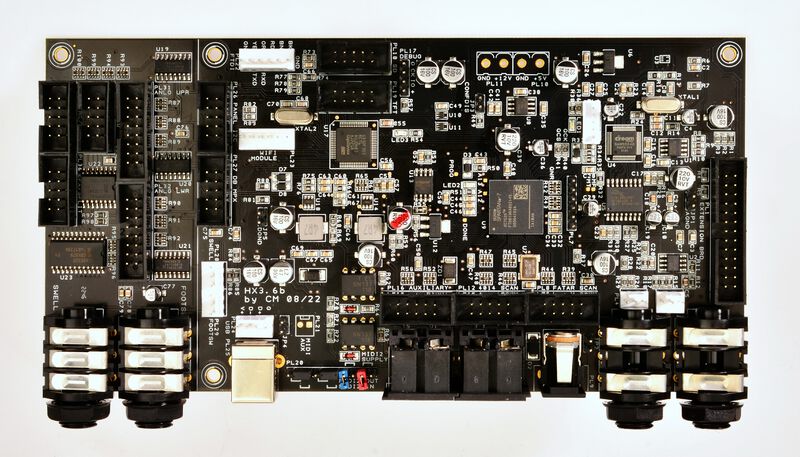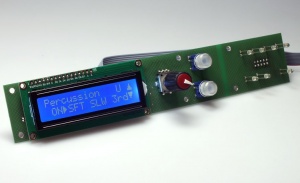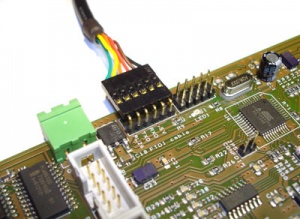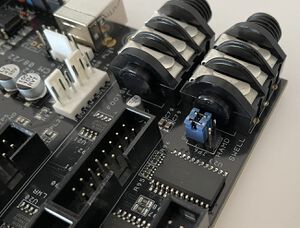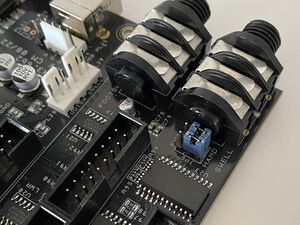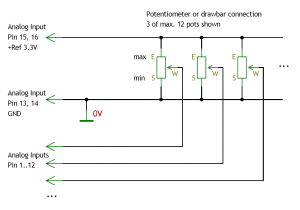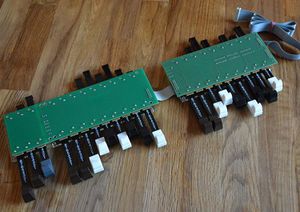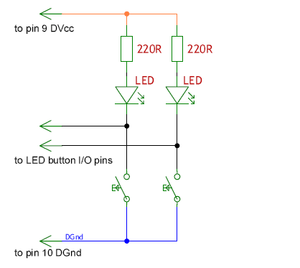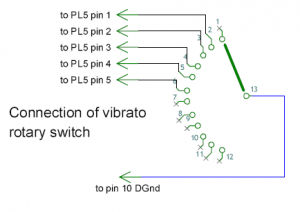HX3.6 Installation Manual: Unterschied zwischen den Versionen
Bovist (Diskussion | Beiträge) |
Bovist (Diskussion | Beiträge) |
||
| (70 dazwischenliegende Versionen von 2 Benutzern werden nicht angezeigt) | |||
| Zeile 1: | Zeile 1: | ||
'''>>[[HX3.6_Installationsanleitung]] (deutsch)''' | '''>>[[HX3.6_Installationsanleitung]] (deutsch)''' | ||
<span style="color:red> '''Version of | <span style="color:red> '''Version of August 28th 2024, as of firmware version 6.036 and up'''</span> | ||
'''HX3.6 single-board sound engine for connecting any keyboard, for installation into existing organs or MIDI control''' | '''HX3.6 single-board sound engine for connecting any keyboard, for installation into existing organs or MIDI control''' | ||
| Zeile 10: | Zeile 10: | ||
== Preface == | == Preface == | ||
HX3.6 should be installed by a qualified technician only. You should be familiar with ribbon cable mounting, crimp contact installation and soldering of delicate parts. Important: Boards contains static sensitive components. Be sure to use anti-static tools and grounded soldering toolset. HX3.6 firmware versions are available for MIDI control as well as direct keyboard control by means of our FatarScan2, Scan61-Inline, Scan16-Strip and (obsolete) OrganScan61 boards. | HX3.6 should be installed by a qualified technician only. You should be familiar with ribbon cable mounting, crimp contact installation and soldering of delicate parts. Important: Boards contains static sensitive components. Be sure to use anti-static tools and grounded soldering toolset. HX3.6 firmware versions are available for MIDI control as well as direct keyboard control by means of our FatarScan2, Scan61-Inline, Scan16-Strip and (obsolete) OrganScan61 boards. For upgrade from HX3.5 to HX3.6, also see the '''[[HX3.6 Migration Guide (english)]]'''. | ||
* HX3.6 mainboard is factory programmed as MIDI expander. It will work after power-up '''without any additional boards attached''' (i.e. open pin headers). | * HX3.6 mainboard is factory programmed as MIDI expander. It will work after power-up '''without any additional boards attached''' (i.e. open pin headers). | ||
| Zeile 20: | Zeile 20: | ||
* See '''[http://updates.keyboardpartner.de/Files/Manuals%20%28Anleitungen%29/UserManual_HX36_Mainboard.pdf HX3.6 Mainboard User Manual, printable PDF file]''' for usage instructions after installation. | * See '''[http://updates.keyboardpartner.de/Files/Manuals%20%28Anleitungen%29/UserManual_HX36_Mainboard.pdf HX3.6 Mainboard User Manual, printable PDF file]''' for usage instructions after installation. | ||
* ''HX3.6 Editor'' (required for installation) now is part of the ''HX3.6 Manager'' package. A complete user manual is available as PDF for download '''[http://updates.keyboardpartner.de/Files/Manuals%20%28Anleitungen%29/ | * ''HX3.6 Editor'' (required for installation) now is part of the ''HX3.6 Manager'' package. A complete user manual is available as PDF for download '''[http://updates.keyboardpartner.de/Files/Manuals%20%28Anleitungen%29/UserManual_HX3_Manager.pdf on our Update Server]'''. | ||
== Connectors and Jumpers == | == Connectors and Jumpers == | ||
[[Datei:HX36_mainboard_vert_1.png|480px|thumb|right|HX3.6 Components/Connector placement (also avalable as PDF, see [http://keyboardpartner.remotewebaccess.com/Files/index.php on our '''Documentation and Update Server'''])]] | [[Datei:HX36_mainboard_vert_1.png|480px|thumb|right|HX3.6 Components/Connector placement (also avalable as PDF, see [http://keyboardpartner.remotewebaccess.com/Files/index.php on our '''Documentation and Update Server'''])]] | ||
HX3.6 offers a wide range of connection options for universal use. Don't let this confuse you, for basic operation it is sufficient to connect the power supply and, if necessary, the MenuPanel to '''PANEL I2C'''. Unused connections can simply be left open. Max. cable length for Fatar scan board is 50cm, for other scan boards 1.5m. Max. cable length for I2C and MPX bus including all segments as well as onboard button and drawbar inputs is 1m. Keep cables as short as possible. | |||
{|class="wikitable" border="1" cellpadding="4" cellspacing="0" style="text-align:left;width: 40%;background-color:#F8F8F8;" | {|class="wikitable" border="1" cellpadding="4" cellspacing="0" style="text-align:left;width: 40%;background-color:#F8F8F8;" | ||
| Zeile 45: | Zeile 47: | ||
|- | |- | ||
!style="width: 10%" | PL6 | !style="width: 10%" | PL6 | ||
| DSP Debug (do not use) | |style="background-color:#F9C6BA"| DSP Debug (do not use) | ||
|- | |- | ||
!style="width: 10%" | PL7 | !style="width: 10%" | PL7 | ||
| Zeile 57: | Zeile 59: | ||
|- | |- | ||
!style="width: 10%" | PL10 | !style="width: 10%" | PL10 | ||
|style="background-color:#A6C9EC"| DC input/ | |style="background-color:#A6C9EC"| DC input/ouput, 5V/500mA | ||
|- | |- | ||
!style="width: 10%" | PL11 | !style="width: 10%" | PL11 | ||
| Zeile 108: | Zeile 110: | ||
|- | |- | ||
!style="width: 10%" | PL27 | !style="width: 10%" | PL27 | ||
|style="background-color:#A6D2AD"| MPX bus (DBX drawbar | |style="background-color:#A6D2AD"| MPX bus (DBX drawbar, PTX pot and ANX boards) | ||
|- | |- | ||
!style="width: 10%" | PL28 | !style="width: 10%" | PL28 | ||
|style="background-color:#D1CCE6"| 3-pin connector | |style="background-color:#D1CCE6"| 3-pin connector rotary control foot switch (note wrong label "SWELL" on older PCB!) | ||
|- | |- | ||
!style="width: 10%" | PL29 | !style="width: 10%" | PL29 | ||
|style="background-color:#D1CCE6"| 3-pin connector | |style="background-color:#D1CCE6"| 3-pin connector FC-7 compatible swell pedal (note wrong label "FOOTSW" on older PCB!) | ||
|- | |- | ||
!style="width: 10%" | PL30 | !style="width: 10%" | PL30 | ||
| Zeile 138: | Zeile 140: | ||
|} | |} | ||
<br> | <br> | ||
{|class="wikitable" border="1" cellpadding="4" cellspacing="0" style="text-align:left;width: 40%;background-color:# | {|class="wikitable" border="1" cellpadding="4" cellspacing="0" style="text-align:left;width: 40%;background-color:#FFAEAE;" | ||
!colspan="2" style="background-color:#d0d0d0;" | HX3.6 Mainboard Jumper | !colspan="2" style="background-color:#d0d0d0;" | HX3.6 Mainboard Jumper | ||
|- | |- | ||
| Zeile 161: | Zeile 163: | ||
== Power Supply == | == Power Supply == | ||
The HX3.6 board may be powered either from coaxial '''DC input PL9''' (5.5/2.1 mm plug, plus on center pin, DC 9V 500mA wall wart) or from '''green DC connectors''' PL11 (9 to 12V input) or PL10 (5V input; 5V output when power provided to DC jack PL10 or | The HX3.6 board may be powered either from coaxial '''DC input PL9''' (5.5/2.1 mm plug, plus on center pin, DC 9V 500mA wall wart) or from '''green DC connectors''' PL11 (9 to 12V input) or PL10 (5V input; 5V output when 9 to 12V power provided to DC jack PL10 or PL9). '''Voltages exceeding 5.2V on PL10 will destroy the board!''' | ||
If you have to use an external '''5V DC''' supply on '''DC input PL10''', insert JP2 (near DC jack). We do not recommend this configuration since inadvertently connecting a DC supply with more than 5V output '''will destroy the board!''' | If you have to use an external '''5V DC''' supply on '''DC input PL10''', insert JP2 (near DC jack). We do not recommend this configuration since inadvertently connecting a DC supply with more than 5V output '''will destroy the board!''' | ||
After powering on, a red LED near PL17 will flicker briefly; it will also flicker when the HX3.6 controller is busy. When the RealOrgan Sound Engine is ready, a yellow LED will dim; it will "breathe" with rotary simulation speed. When the Effects/GM DSP is ready, a blue LED will flash every second. The blue LED will blink on/3x briefly off when the DSP is ready to accept a DFU firmware update by USB. | After powering on, a red LED near PL17 will flicker briefly; it will also flicker when the HX3.6 controller is busy. When the RealOrgan Sound Engine is ready, a yellow LED will dim; it will "breathe" with rotary simulation speed. When the Effects/GM DSP is ready, a blue LED will flash every second. The blue LED will blink on/3x briefly off when the DSP is in Bootload mode, ready to accept a DFU firmware update by USB. | ||
== Preparing HX3.6 for | == Preparing HX3.6 for First Use == | ||
From factory HX3.6 boards are programmed with MIDI Expander firmware (no analog inputs). It should deliver a basic organ sound on audio outputs with MIDI input even with no other peripherals connected. Basic functions are available if a MenuPanel is connected. You have to set at least some '''System Init''' parameters after installing a different firmware. See '''Installation by HX3.6 Manager''' section below. | From factory HX3.6 boards are programmed with MIDI Expander firmware (no analog inputs). It should deliver a basic organ sound on audio outputs with MIDI input even with no other peripherals connected. Basic functions are available if a MenuPanel is connected. You have to set at least some '''System Init''' parameters after installing a different firmware. See '''Installation by HX3.6 Manager''' section below. | ||
| Zeile 183: | Zeile 185: | ||
[[Datei:ftdi.jpg|300px|thumb|right|'''FTDI cable connected to HX3''']] | [[Datei:ftdi.jpg|300px|thumb|right|'''FTDI cable connected to HX3''']] | ||
For | For board configuration you may use a serial connection through FTDI USB adaptor cable or USB interface connected to PL19 (cable colors imprinted). This port ist mostly used for factory programming and not needed for customer use. We recommend using the USB port MIDI interface. See '''[http://updates.keyboardpartner.de/Files/Manuals%20%28Anleitungen%29/UserManual_HX3_Manager.pdf HX3 Manager User Manual, printable PDF file]''' for details. | ||
=== Configuration by SD Card === | === Configuration by SD Card === | ||
| Zeile 195: | Zeile 197: | ||
Advanced users may create their own INI scripts containig all neccessary commands which do basically the same as HX3.6 Editor. See page '''[[HX3.6 SD Card Usage]]''' for details. | Advanced users may create their own INI scripts containig all neccessary commands which do basically the same as HX3.6 Editor. See page '''[[HX3.6 SD Card Usage]]''' for details. | ||
=== Configuration by HX3 | === Configuration by HX3 Manager=== | ||
Alternatively, connect HX3.6 to your PC via USB. Start '''HX3.6 Manager''', connect to HX3.6 and open '''Updater''' window. Complete or partly updates may be triggered by menus. "Get Board Info" should show current configuration. See '''[http://updates.keyboardpartner.de/Files/Manuals%20%28Anleitungen%29/ | Alternatively, connect HX3.6 to your PC via USB. Start '''HX3.6 Manager''', connect to HX3.6 and open '''Updater''' window. Complete or partly updates may be triggered by menus. "Get Board Info" should show current configuration. See '''[http://updates.keyboardpartner.de/Files/Manuals%20%28Anleitungen%29/UserManual_HX3_Manager.pdf HX3 Manager User Manual, printable PDF file]''' for details. | ||
Checklist: | Checklist: | ||
| Zeile 207: | Zeile 209: | ||
* Are analog volume inputs working? Non-working analog inputs may have been remapped to "not assigned". See '''Analog Remap''' group. | * Are analog volume inputs working? Non-working analog inputs may have been remapped to "not assigned". See '''Analog Remap''' group. | ||
=== Updates === | === Bootloader Updates === | ||
As the Updater via MIDI/USB is slow on large files (FPGA sound engine, firmware, presets), we recommend the ''Bootloader Update'' procedure for these parts. Set the HX3.6 board to ''BootLoad'' mode by navigating to MenuPanel submenu "Bootld Update" or pressing MenuPanel encoder knob while powering on. Open '''HX3 Manager Bootload (HX3.6)''' app. Select parts to be updated in "Update" column and click "Send DFU Pack". For '''DSP firmware, DSP sound banks''' or pre-packed DFU update files, click "Single DFU file". HX3.7 will unpack uploads automatically, see MenuPanel display for progress. | |||
See page '''[http://updates.keyboardpartner.de/Files/Manuals%20%28Anleitungen%29/UserManual_HX3_Manager.pdf HX3 Manager User Manual, printable PDF file]''' or page '''[[HX3.6 SD Card Usage]]''' for details. | |||
See page '''[http://updates.keyboardpartner.de/Files/Manuals%20%28Anleitungen%29/ | |||
==Parameter Tweaking == | ==Parameter Tweaking == | ||
| Zeile 294: | Zeile 294: | ||
|} | |} | ||
==Audio | ==Audio Output Jacks== | ||
In addition to left/right 1/4" audio jacks, the stereo audio signal is present on PL3 (center = analog ground). Audio level is 300mV RMS nominal. | |||
==Swell and Footswitch Jacks== | |||
A single or dual footswitch may be connected to PL27. Set ''System Inits'' in '''HX3 Manager/Editor''' according to footswitch type (default: latching switches). | |||
A standard potentiometer-type swell pedal like Yamaha FC-7 may be connected to '''PL30''' 1/4" jack. Swell function is also available via MIDI controller; however, MIDI loudness resolution is limited. | |||
HX3.6 board revision '''b2''' has two additional jumpers to reverse tip/ring connection of swell pedal, located behind SWELL jack. Select the HAMD position if your swell pedal has a different pin assignment than the Yamaha FC7 (for FC7: Plug tip = reference voltage, potentiometer end position, plug ring = analog input, potentiometer wiper). HAMD position swaps tip and ring of swell jack. This may also applicable for some other brands (CASIO etc). | |||
<br> | |||
[[Datei:Hx36_jp_fc7.jpg|300px|thumb|right|HX3.6b2 Jumper set for FC7: Tip = reference voltage, potentiometer end position, ring = potentiometer wiper]] | |||
[[Datei:Hx36_jp_hmd.jpg|300px|thumb|right|HX3.6b2 Jumper set for Hammond (also some others): Tip = analog input, potentiometer wiper, ring = reference voltage]] | |||
{|class="wikitable" border="1" cellpadding="4" cellspacing="0" style="text-align:left;width: 40%;background-color:#FFAEAE;" | |||
!colspan="2" style="background-color:#d0d0d0;" | HX3.6b2 Additional Jumpers | |||
|- | |||
! JP6, JP7 | |||
| Select Hammond or Yamaha FC7 pinout of swell pedal jack | |||
|- | |||
|colspan="2" style="background-color:#f0f0f0;"| ''Default jumper setting: 2 jumpers in position FC7'' | |||
|} | |||
==Connecting Analog Inputs== | ==Connecting Analog Inputs== | ||
| Zeile 441: | Zeile 460: | ||
Please note: Open analog inputs (unconnected) will "float" and change randomly, even with presets active. Disable unused inputs with HX3.6 Editor's ''Analog Remap'' section (set to "254 - Not assigned"). | Please note: Open analog inputs (unconnected) will "float" and change randomly, even with presets active. Disable unused inputs with HX3.6 Editor's ''Analog Remap'' section (set to "254 - Not assigned"). | ||
==External Analog Inputs (MPX Bus)== | |||
==External Analog Inputs ( | |||
[[Datei:DBX9.JPG|300px|thumb|right|'''DBX9 drawbar set for connection to [[MPX Bus]] input, shortened on right side to fit into organ (click picture to enlarge)''']] | |||
====See page '''[[MPX Bus]]''' for details on external analog inputs.==== | |||
==Connecting Digital Inputs== | ==Connecting Digital Inputs== | ||
| Zeile 1.060: | Zeile 571: | ||
Panel16 has 4 "Common Preset" keys in the layout for standard organ installations. The "Common Preset" keys are binary coded so that more than one preset key can be active (pressed simultaneously). This allows 16 key combinations (all off to all on) corresponding to Common Presets 0 (live) to 15. Alternatively, these keys can be used to select V1-V3 vibrato or C1-C3 chorus depth. In this case, the Vibrato rotary switch on PL24 is omitted; then set ''System Inits'' parameter #1497 to 2. | Panel16 has 4 "Common Preset" keys in the layout for standard organ installations. The "Common Preset" keys are binary coded so that more than one preset key can be active (pressed simultaneously). This allows 16 key combinations (all off to all on) corresponding to Common Presets 0 (live) to 15. Alternatively, these keys can be used to select V1-V3 vibrato or C1-C3 chorus depth. In this case, the Vibrato rotary switch on PL24 is omitted; then set ''System Inits'' parameter #1497 to 2. | ||
{|class="wikitable" border="1" cellpadding="4" cellspacing="0" style="text-align:center;width: 63%;background-color:#ffffcc;" | {|class="wikitable" border="1" cellpadding="4" cellspacing="0" style="text-align:center;width: 63%;background-color:#ffffcc;" | ||
| Zeile 1.101: | Zeile 611: | ||
|} | |} | ||
Buttons used for Common Presets, Drawbar Voices or V1..V3 V/C may be remapped deliberately to any digital input using the ''Switch Remap'' table in the HX3 Editor application. | Buttons used for Common Presets, Drawbar Voices or V1..V3 V/C may be remapped deliberately to any digital input using the ''Switch Remap'' table in the HX3 Editor application. | ||
===Vibrato Knob (Rotary Switch)=== | ===Vibrato Knob (Rotary Switch)=== | ||
| Zeile 1.442: | Zeile 658: | ||
|- | |- | ||
|} | |} | ||
To assign vibrato keys, set the corresponding inputs in the ''Switch Remap'' section to 84, 85, 87 (three-key mode) or 84..87 (four-key mode). The ''System Inits'' parameter #1504 = 1 is ignored. | To assign vibrato keys, set the corresponding inputs in the ''Switch Remap'' section to 84, 85, 87 (three-key mode) or 84..87 (four-key mode). The ''System Inits'' parameter #1504 = 1 is ignored. | ||
== | ==External Buttons or Switches (I2C Bus)== | ||
====See '''[[I2C Bus]]''' page for details on external digital inputs.==== | |||
== | ==Connecting Keyboard Scan Board(s)== | ||
== | |||
====See page '''[[Scan Boards]]''' for details on connecting keyboard scan board(s).==== | |||
==Extension Board== | ==Extension Board== | ||
| Zeile 1.572: | Zeile 676: | ||
The old Extension Board for '''HX3.4 (mk3/mk4)''' may be used after removing two resistors from the Extension Board and soldering two wires on the rear side of the HX3.6 mainboard from Extension Board connector to serial port. | The old Extension Board for '''HX3.4 (mk3/mk4)''' may be used after removing two resistors from the Extension Board and soldering two wires on the rear side of the HX3.6 mainboard from Extension Board connector to serial port. | ||
''' | See page '''[[HX3.5 Extension Board]]''' for details. | ||
Aktuelle Version vom 6. Januar 2025, 12:18 Uhr
>>HX3.6_Installationsanleitung (deutsch)
Version of August 28th 2024, as of firmware version 6.036 and up
HX3.6 single-board sound engine for connecting any keyboard, for installation into existing organs or MIDI control
Preface
HX3.6 should be installed by a qualified technician only. You should be familiar with ribbon cable mounting, crimp contact installation and soldering of delicate parts. Important: Boards contains static sensitive components. Be sure to use anti-static tools and grounded soldering toolset. HX3.6 firmware versions are available for MIDI control as well as direct keyboard control by means of our FatarScan2, Scan61-Inline, Scan16-Strip and (obsolete) OrganScan61 boards. For upgrade from HX3.5 to HX3.6, also see the HX3.6 Migration Guide (english).
- HX3.6 mainboard is factory programmed as MIDI expander. It will work after power-up without any additional boards attached (i.e. open pin headers).
- For updates and HX3.6 Manager download, visit the HX3.6 Files Page for most recent and beta firmware, manuals, schematics and tools. Updates in ZIP file (named HX36_Update_6xxx.zip) contain HX3.6 Manager application as well as DSP firmware, sound bank(s), FPGA configuration images and scan drivers.
- A complete set of PDF schematics including peripherals is available for download on our Schematics Page and Drawings Page.
- See HX3.6 Mainboard User Manual, printable PDF file for usage instructions after installation.
- HX3.6 Editor (required for installation) now is part of the HX3.6 Manager package. A complete user manual is available as PDF for download on our Update Server.
Connectors and Jumpers
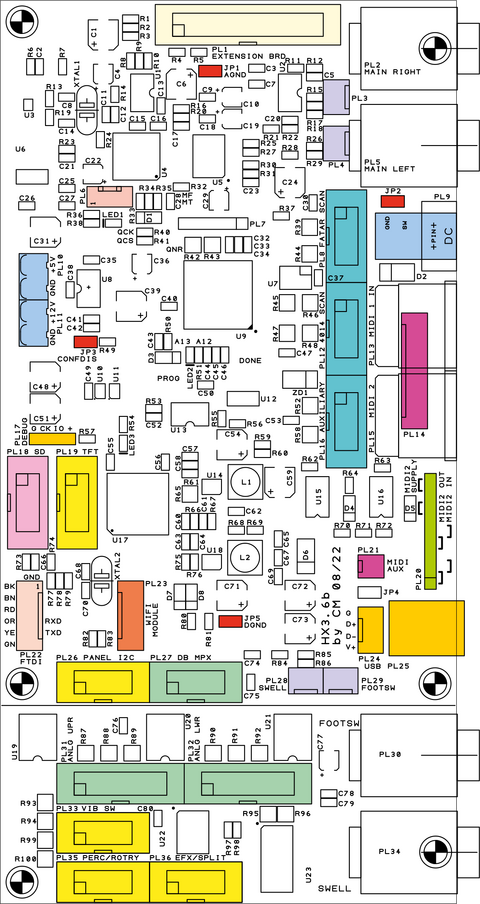
HX3.6 offers a wide range of connection options for universal use. Don't let this confuse you, for basic operation it is sufficient to connect the power supply and, if necessary, the MenuPanel to PANEL I2C. Unused connections can simply be left open. Max. cable length for Fatar scan board is 50cm, for other scan boards 1.5m. Max. cable length for I2C and MPX bus including all segments as well as onboard button and drawbar inputs is 1m. Keep cables as short as possible.
| HX3.6 Mainboard connectors | |
|---|---|
| PL1 | HX3 Extension Board (optional) |
| PL2 | 6,3mm jack audio output right |
| PL3 | Stereo audio output; mid = GND |
| PL4 | Stereo audio mixer input; mid = GND |
| PL5 | 6,3mm jack audio output left |
| PL6 | DSP Debug (do not use) |
| PL7 | FPGA Debug (do not use) |
| PL8 | Scan Board (FatarScan2) |
| PL9 | DC input, 5V or 9..12V/500mA, Plus on center contact |
| PL10 | DC input/ouput, 5V/500mA |
| PL11 | DC input, 9..12V/500mA |
| PL12 | Scan Board (Scan16-Strip, Scan61-Inline, OrganScan61 or Bass25) |
| PL13 | MIDI IN1 |
| PL14 | MIDI IN1/IN2/OUT (if external jacks see schematics) |
| PL15 | MIDI IN2/OUT (as configered by jumpers on PL20) |
| PL16 | Aux digital I/O, for some scan drivers sustain and cancel inputs (active low) |
| PL17 | ARM Cortex M3 Debug (do not use) |
| PL18 | SD card adapter (or ISP AVR) |
| PL19 | Connector for FT800 grafical display |
| PL20 | MIDI IN/OUT configuration jumpers |
| PL21 | MIDI control for MAG Vent, TTL level |
| PL22 | Serial interface for FTDI cable |
| PL23 | Bluetooth or WiFi module (BLE) |
| PL24 | 4-pin connector USB to HX3.5 Extension Board |
| PL25 | USB jack (MIDI over USB, updates) |
| PL26 | I2C bus (menu panel/preset boards) |
| PL27 | MPX bus (DBX drawbar, PTX pot and ANX boards) |
| PL28 | 3-pin connector rotary control foot switch (note wrong label "SWELL" on older PCB!) |
| PL29 | 3-pin connector FC-7 compatible swell pedal (note wrong label "FOOTSW" on older PCB!) |
| PL30 | 6,3mm jack rotary control |
| PL31 | Analog inputs 0 to 11 (default drawbars upper manual) |
| PL32 | Analog inputs 12 to 23, (default drawbars lower manual) |
| PL33 | Vibrato rotary switch (optional) |
| PL34 | 6,3mm jack swell pedal (FC-7 compatible) |
| PL35 | Buttons/switches 0 to 7 (default percussion, vib on, rotary control) |
| PL36 | Buttons/switches 8 to 15 (default presets or vibrato buttons, reverb, bypass, split |
| HX3.6 Mainboard Jumper | |
|---|---|
| JP1 | Analog Gnd (Probe Connection), both pins |
| JP2 | 5V DC input on PL10/PL12 (wall wart connector) if jumpered |
| JP3 | Config Disable (do not use) |
| JP4 | Power supply over USB (can cause noise) |
| JP5 | Digital Gnd (Probe Connection), both pins |
| Default jumper setting: 2 jumpers on PL20 pin 2-3 and 5-6 (leftmost pin is 1) for second MIDI IN | |
Power Supply
The HX3.6 board may be powered either from coaxial DC input PL9 (5.5/2.1 mm plug, plus on center pin, DC 9V 500mA wall wart) or from green DC connectors PL11 (9 to 12V input) or PL10 (5V input; 5V output when 9 to 12V power provided to DC jack PL10 or PL9). Voltages exceeding 5.2V on PL10 will destroy the board!
If you have to use an external 5V DC supply on DC input PL10, insert JP2 (near DC jack). We do not recommend this configuration since inadvertently connecting a DC supply with more than 5V output will destroy the board!
After powering on, a red LED near PL17 will flicker briefly; it will also flicker when the HX3.6 controller is busy. When the RealOrgan Sound Engine is ready, a yellow LED will dim; it will "breathe" with rotary simulation speed. When the Effects/GM DSP is ready, a blue LED will flash every second. The blue LED will blink on/3x briefly off when the DSP is in Bootload mode, ready to accept a DFU firmware update by USB.
Preparing HX3.6 for First Use
From factory HX3.6 boards are programmed with MIDI Expander firmware (no analog inputs). It should deliver a basic organ sound on audio outputs with MIDI input even with no other peripherals connected. Basic functions are available if a MenuPanel is connected. You have to set at least some System Init parameters after installing a different firmware. See Installation by HX3.6 Manager section below.
MenuPanel
Our MenuPanel allows convenient adjustments of various HX3 parameters to tweak your setup. Two versions available, short one without indicator LEDs intended for organ installation.
Connect HX3 MenuPanel to PL26 PANEL using a 10-wire flat ribbon cable. If you use the HX3 MenuPanel in parallel/simultaneously with Preset12-2 and Preset16 boards, it should be the last module on the chain connected to PL26, since it has only one bus connector.
Newer long version menu panels have a separate connector for the 7 LEDs that goes to PL35 on the mainboard.
Serial USB cable
For board configuration you may use a serial connection through FTDI USB adaptor cable or USB interface connected to PL19 (cable colors imprinted). This port ist mostly used for factory programming and not needed for customer use. We recommend using the USB port MIDI interface. See HX3 Manager User Manual, printable PDF file for details.
Configuration by SD Card
If an SD card adapter with an FAT 32 formatted SD card is detected, HX3.6 starts up in bootloader mode. To perform an update from the SD card press the menu panel encoder button. Only those parts are updated for which a corresponding file (.BIN, .DAT) is found on the card.
Alternatively to single files a single packed DFU file can be created with the HX3.6 Manager BootLoad and stored on the card. It is treated by HX3.6 exactly like a DFU update via USB cable. Updates are usually delivered by us as such a DFU file.
Please note: If new firmware has been installed, some System Inits settings are persistent and may need to be changed for your configuration to work.
Advanced users may create their own INI scripts containig all neccessary commands which do basically the same as HX3.6 Editor. See page HX3.6 SD Card Usage for details.
Configuration by HX3 Manager
Alternatively, connect HX3.6 to your PC via USB. Start HX3.6 Manager, connect to HX3.6 and open Updater window. Complete or partly updates may be triggered by menus. "Get Board Info" should show current configuration. See HX3 Manager User Manual, printable PDF file for details.
Checklist:
- Is MIDI IN working? Brand new boards should deliver a basic organ sound on audio outputs with MIDI input on MIDI channel 1. Right 5-pin DIN connector (seen from back) is always a MIDI IN.
- Is an appropiate Scan Driver installed? You may replace the Scan Driver by using the Updater in HX3.6 Manager. Use Update menu and select "Scan Driver file". HX3.6 Updater will prompt for a DAT file, open either scanmidi.dat, scansr61.dat, or scanfatr.dat, depending on your needs.
- Are HX3.6 System Inits correct? HX3.6 will not scan buttons or analog inputs if not set correctly. Use the Editor in HX3.6 Manager and click on pink System Inits button. Click Get Group in the Action menu to refresh table entries.
- Are analog drawbar inputs working? With all analog inputs enabled (parameter 1503>1), check if changes on drawbars are to be seen on Upper DB rsp. all other analog input groups when clicking Get Group button.
- Are analog volume inputs working? Non-working analog inputs may have been remapped to "not assigned". See Analog Remap group.
Bootloader Updates
As the Updater via MIDI/USB is slow on large files (FPGA sound engine, firmware, presets), we recommend the Bootloader Update procedure for these parts. Set the HX3.6 board to BootLoad mode by navigating to MenuPanel submenu "Bootld Update" or pressing MenuPanel encoder knob while powering on. Open HX3 Manager Bootload (HX3.6) app. Select parts to be updated in "Update" column and click "Send DFU Pack". For DSP firmware, DSP sound banks or pre-packed DFU update files, click "Single DFU file". HX3.7 will unpack uploads automatically, see MenuPanel display for progress.
See page HX3 Manager User Manual, printable PDF file or page HX3.6 SD Card Usage for details.
Parameter Tweaking
Adding hardware to your HX3.6 board may require some parameter tweaking to get it running. By factory, HX3.6 is configured as a MIDI expander; it will not poll or drive any peripherals attached except the MenuPanel. For example, if you attach the FatarScan2 board, you need to update the scan driver as well. If you attach drawbars, buttons or switches, you need to enable these.
As of today, tweaking parameters that are not present in the menu system is only possible by HX3.6 Editor.
MIDI Configuration
The HX3.6 board is configured by factory as MIDI Expander with two MIDI inputs. Left MIDI DIN connector (seen from back) is MIDI IN2 by default. It may be configured as MIDI OUT by changing jumper setting on pin header PL18 according to following table (pin 1 is near USB connector, pin 10 is near DIN socket). For +5V phantom supply on MIDI IN set jumpers on pins 7-8 and 9-10. When phantom supply jumpers are installed, DIN jack carries ground on middle pin 2 and +5V on two otherwise unused outer pins 1 and 3. Phantom supply may be used to power BASS25 MIDI scan board connected to left DIN socket.
| PL20 - function of left MIDI jack | ||||||
|---|---|---|---|---|---|---|
| Funktion | JP on pin | JP on pin | Gnd (blue) JP on pin |
Vcc (red) JP on pin | ||
| MIDI OUT | 1-2 | 4-5 | 7-8 | open | ||
| MIDI IN | 2-3 | 5-6 | open | open | ||
| MIDI IN w/ phantom +5V |
2-3 | 5-6 | 7-8 | 9-10 | ||
| Pin 1 is left, seen from back | ||||||
MIDI over USB is available if USB socket PL25 is installed, Mini USB socket adaptor (optional) or HX3 Extension Board is connected by cable to PL32. Please note: Due to hardware restrictions, MIDI IN2 and USB MIDI IN must not be used simultaneously. Transmission errors will occur!
USB Port
An USB type B connector may be soldered to position PL25 if needed. It is not populated by factory to ensure mechanical compatibility with existing rear panels. In addition, the USB signal is available on header PL24 (near USB jack) to route USB to our HX3.5 extension board. The USB port is configured as a "MIDI over USB" device by default. In DFU update mode it becomes the port for the HX3.6 DSP update application.
Important: When using a "MIDI over USB" connection (as the HX3 Manager does), disconnect any MIDI device from secondary (left) MIDI input DIN jack as they share the same MIDI input line.
USB port is also used for DSP firmware or soundbank updates.
Mini USB Adaptor installation
For use with the HX3.4 back panel with mini-USB cutout, connect the mini-USB adapter as follows:
| HX3.6 PL24 | USB adapter | USB cable color |
|---|---|---|
| G | GND | black |
| D + | D + | green |
| D - | D - | white |
| V + | VCC | red |
Audio Output Jacks
In addition to left/right 1/4" audio jacks, the stereo audio signal is present on PL3 (center = analog ground). Audio level is 300mV RMS nominal.
Swell and Footswitch Jacks
A single or dual footswitch may be connected to PL27. Set System Inits in HX3 Manager/Editor according to footswitch type (default: latching switches).
A standard potentiometer-type swell pedal like Yamaha FC-7 may be connected to PL30 1/4" jack. Swell function is also available via MIDI controller; however, MIDI loudness resolution is limited.
HX3.6 board revision b2 has two additional jumpers to reverse tip/ring connection of swell pedal, located behind SWELL jack. Select the HAMD position if your swell pedal has a different pin assignment than the Yamaha FC7 (for FC7: Plug tip = reference voltage, potentiometer end position, plug ring = analog input, potentiometer wiper). HAMD position swaps tip and ring of swell jack. This may also applicable for some other brands (CASIO etc).
| HX3.6b2 Additional Jumpers | |
|---|---|
| JP6, JP7 | Select Hammond or Yamaha FC7 pinout of swell pedal jack |
| Default jumper setting: 2 jumpers in position FC7 | |
Connecting Analog Inputs
HX3.6 provides 24 internal analog inputs, all located on pin headers PL31 and PL32, as well as up to 64 external analog inputs via DBX6, DBX9, DBX12 drawbars and PTX4-25/35 potentiometer assemblies connected to PL27 MPX bus input. All analog inputs are DC controlled. Input voltage range is from 0V (off or minimal volume) to +3.3V (max. volume). With factory configuration all analog inputs are disabled, so that HX3.6 may be used without any switches/drawbars/pots connected. You may leave internal connectors PL31 and PL32 open if you plan to control by MIDI only.
Assigning Analog Inputs
To enable analog control inputs, use the HX3.6 Editor application to set parameter #1503 to value 2 (when old DB9-MPX drawbars are to be used on PL31/PL32) or 3 (otherwise). Individual analog inputs may be disabled or re-routed in the HX3.6 Editor's Analog Remap section, parameters #5000 to #5023 (for internal inputs PL22/PL23) and #5024 to #5088 (external inputs on PL20). See section HX3.6_Installation_Manual#Mixing_DB9.2FDB12_and_DBX_Drawbar_Sets for details.
When individual internal input pins on PL31/PL32 are not used (i.e. remain open, no drawbar or pot installed), set corresponding parameter #5000..#5023 to "254 - Not assigned". To disable all internal inputs on PL31/PL32, set parameter #5000 to "255 - End of table". Same applies to PL27 MPX bus inputs: If no additional DBX or PTX boards are connected, set parameter #5024 to "255 - End of table".
Note: Do not assign an organ function to more than one analog input.
Input Check & Monitoring
All assigned inputs should be connected to a physical control. Otherwise, inputs will "float" and HX3.6 will send random MIDI control values at a high rate; this can make an update impossible.
HX3.6 Editor provides a monitoring function to check physical button states and raw analog input voltages. Click "Input Monitor" button and tick checkboxes of input types you want to monitor. Input voltage changes should appear immediately in the table(s). When you click on a table entry, the main table jumps to the associated assignment group.
Internal Analog Inputs
To use internal analog inputs on PL31 and PL32, set System Inits parameter #1503 to 2 or 3. Set Analog Remap parameters #5000 to #5023 according to your pin assignment. By default, pin assignment is set to HX3.4 DB9/DB12 compatibility.
Connecting Drawbar Boards DB9/DB11/DB12
Classic drawbar sets DB9/DB11/DB12 may be used for single drawbar set configurations. Connection to our old drawbar boards DB9 and DB12 is simple: DB9 (upper) connects to PL31 ANLG UPR, DB12 (lower) connects to PL32 ANLG LWR via 16-wire flat ribbon cable (length up to 1m, plugs wired 1:1). DB9 provides 3-pin headers for connection of Tone and Amp122 Volume pots.
Additional DB9-MPX boards (obsolete - use DBX drawbar modules instead) may be inserted for configurations with dual drawbar sets per manual. Secondary DB9-MPX drawbar sets should be located right to corresponding primary DB9 or DB12 drawbars as on Hammond Consoles. A short flat ribbon cable connects both (see picture).
DB9 and DB11/12 are compatible and interchangeable, despite additional drawbars for bass pedals resp. tone/amp volume.
Connecting other Drawbar Pots
You may also use your own or existing drawbars as follows: At least connect 9 drawbars or slider pots and Leslie volume control pot to PL31 ANLG UPR. R value should be in the 10 kOhm to 47 kOhm range, linear taper (for example type B10K). Note that using audio taper (log.) drawbar pots as found in various older LSI and transistor organs will not yield correct loudness and drawbar position on MenuPanel display.
Any analog input may be "soft wired" to any analog function with HX3.6 Editor's Analog Remap section. By default, analog functions are mapped to keep HX3.4 compatibility as shown below.
| PL31 ANLG UPR - Control Voltages Upper Manual | |
|---|---|
| Pin 1 | Drawbar 16 |
| Pin 2 | Drawbar 5 1/3 |
| Pin 3 | Drawbar 8 |
| Pin 4 | Drawbar 4 |
| Pin 5 | Drawbar 2 2/3 |
| Pin 6 | Drawbar 2 |
| Pin 7 | Drawbar 1 5/9 |
| Pin 8 | Drawbar 1 1/3 |
| Pin 9 | Drawbar 1 |
| Pin 10 | Master Volume Pot |
| Pin 11 | Amp Pot, simulated tube amp volume |
| Pin 12 | Assigned pot (assignable with HX3.6 Editor) |
| Pin 13, 14 | Drawbar/Pot common ground GND |
| Pin 15 | Drawbar set A/B switching signal (may be tied to pin 16) |
| Pin 16 | Drawbar/Pot end 3.3V+ (reference) |
| PL32 ANLG LWR - Control Voltages Lower Manual | |
|---|---|
| Pin 1 | Drawbar 16 |
| Pin 2 | Drawbar 5 1/3 |
| Pin 3 | Drawbar 8 |
| Pin 4 | Drawbar 4 |
| Pin 5 | Drawbar 2 2/3 |
| Pin 6 | Drawbar 2 |
| Pin 7 | Drawbar 1 5/9 |
| Pin 8 | Drawbar 1 1/3 |
| Pin 9 | Drawbar 1 |
| Pin 10 | Drawbar Bass 16 |
| Pin 11 | Drawbar Bass 8 |
| Pin 12 | Drawbar/Pot Pedal Sustain |
| Pin 13, 14 | Drawbar/Pot common ground GND |
| Pin 15 | Drawbar set A/B switching signal (may be tied to pin 16) |
| Pin 16 | Drawbar/Pot end 3.3V+ (reference) |
Even with MIDI control, a swell pedal should be connected to SWELL jack for faster response. This overrides MIDI volume control. You may connect a swell pedal like Yamaha FC-7 or a simple volume pot to the SWELL jack.
HX3 mainboard is set to tone/treble and amp volume control inputs active by factory (may be altered also with HX3.6 Editor). Tone pot center is connected to pin 10 of PL31. Pin 11 becomes the Leslie amp volume/drive control (mandatory). Amp volume pot center is connected to pin 11 of PL31. Both pots begin with GND and end with Ref 3.3V+.
Please note: Open analog inputs (unconnected) will "float" and change randomly, even with presets active. Disable unused inputs with HX3.6 Editor's Analog Remap section (set to "254 - Not assigned").
External Analog Inputs (MPX Bus)
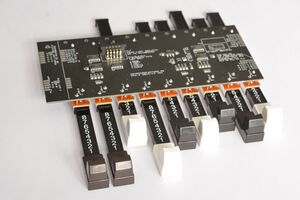
See page MPX Bus for details on external analog inputs.
Connecting Digital Inputs
The HX3.6 system offers a total of 64 internal (logical) switch functions or "tabs" (e.g. "Tube Amp Bypass" or "H100 Keying Mode") as well as some special functions (from firmware 5.7, e.g. Transpose Up/Down). The HX3.6 mainboard provides 16 internal digital inputs onboard on PL35/36 (extendable by 5 external boards Preset16 or Extend16 up to 96 tab and preset functions) plus one rotary swich input. Switches are defined as tab stops, rocker or toggle switches, buttons are momentary switch contacts, normally open. All inputs are active low, i.e. tie to ground when switch/button is operated. You may leave the switch connectors open if you plan to control by MIDI only.
Input Monitor
A very helpful function of HX3.6 Editor versions is the Input Monitor. You can use it to check the function of all buttons and switches. Active (pressed) buttons are marked with "ON".
By clicking into the input table you will also find out to which HX3.6 tab the input or button is assigned. Conversely, when you click on an assignment in Switch Remap, the active field in the input monitor tables jumps to the assigned input.
Onboard Inputs PL35/PL36
The PL35 and PL36 connectors carry the 16 internal digital inputs; you can connect your own pushbuttons/switches or a Panel16 board here (see #Panel16). Many installations will get by with these 16 tabs.
| Pinout PL35 PERC/VIBON/LESL | ||||||||||
|---|---|---|---|---|---|---|---|---|---|---|
| Pins | Pin 1 | Pin 2 | Pin 3 | Pin 4 | Pin 5 | Pin 6 | Pin 7 | Pin 8 | Pin 9 | Pin 10 |
| Input # | #32 | #33 | #34 | #35 | #36 | #37 | #38 | #39 | +5V | Gnd |
| Default function | Perc ON | Perc SOFT | Perc FAST | Perc THIRD | Vib ON Upper |
Vib ON Lower |
Leslie RUN |
Leslie FAST |
+5V | Gnd |
| Pinout PL36 PRESET/EFX/SPLIT | ||||||||||
|---|---|---|---|---|---|---|---|---|---|---|
| Pins | Pin 1 | Pin 2 | Pin 3 | Pin 4 | Pin 5 | Pin 6 | Pin 7 | Pin 8 | Pin 9 | Pin 10 |
| Input # | #40 | #41 | #42 | #43 | #44 | #45 | #46 | #47 | +5V | Gnd |
| Default function | Preset 1 oder V1 |
Preset 2 oder V2 |
Preset 3 oder V3 |
Preset 4 oder V/C |
Reverb I | Reverb II | Bass On Leslie |
Split ON | +5V | Gnd |
Separate Buttons or Switches
Instead of Panel16 you can also connect your own buttons or tab switches (up to 16) directly to the HX3.6 main board. Each function is activated either by a button or a switch (depending on the parameter Button Mask in the system settings of the HX3.6 editor) at the digital inputs PL35/PL36. For buttons, a momentary contact with ground on each PL35/PL36 pin toggles the status and drives indicator LEDs (see schematic). For switches, the indicator LED can be omitted since the mechanical switch indicates the current state. Leave unused digital inputs open.
Panel16
Easiest solution for a register/stop panel is using our Panel16 board connected to PL35 PERC/VIBON/LESL and PL36 PRESET/EFX/SPLIT by two 10-wire flat ribbon cables. Panel16 provides 16 buttons for complete HX3 control; just add the rotary switch for vibrato depth.
Panel16 has 4 "Common Preset" keys in the layout for standard organ installations. The "Common Preset" keys are binary coded so that more than one preset key can be active (pressed simultaneously). This allows 16 key combinations (all off to all on) corresponding to Common Presets 0 (live) to 15. Alternatively, these keys can be used to select V1-V3 vibrato or C1-C3 chorus depth. In this case, the Vibrato rotary switch on PL24 is omitted; then set System Inits parameter #1497 to 2.
| Default Button Assigment Panel16 on PL35/36 | ||||||||||
|---|---|---|---|---|---|---|---|---|---|---|
| Buttons upper row |
Perc ON | Perc SOFT | Perc FAST | Perc THIRD | Vib ON upper | Vib ON lower | Leslie RUN | Leslie FAST | ||
| Buttons lower row with vibrato buttons |
V1 | V2 | V3 | Vib/Chorus | Reverb I | Reverb II | Bass On Leslie | Split ON | ||
| Buttons lower row with preset buttons |
Preset 1 | Preset 2 | Preset 3 | Preset 4 | Reverb I | Reverb II | Bass On Leslie | Split ON | ||
Buttons used for Common Presets, Drawbar Voices or V1..V3 V/C may be remapped deliberately to any digital input using the Switch Remap table in the HX3 Editor application.
Vibrato Knob (Rotary Switch)
Vibrato/chorus V1 to C3 is selected by a rotary switch connected to PL33. The switch position is always polled unless Panel16 is configured with V1..3/Chorus buttons (System Inits parameter #1504, also see note below). PL33 also carries switching signals, indicating rotary operation. You may connect a LED with serial resistor (330R and up) here, cathode (-) connected to Common Gnd.
Pinout PL33 VIBSW Vibrato rotary switch (active low – switch to Gnd):
| PL33 Vibrato Switch | |||||||||
|---|---|---|---|---|---|---|---|---|---|
| Pin | Funktion | ||||||||
| 1 | Chorus 1 | ||||||||
| 2 | Vibrato 2 | ||||||||
| 3 | Chorus 2 | ||||||||
| 4 | Vibrato 3 | ||||||||
| 5 | Chorus 3 | ||||||||
| 6 | not used | ||||||||
| 7 | Rotary Slow Indicator (active high) | ||||||||
| 8 | Rotary Fast Indicator (active high) | ||||||||
| 9 | not used | ||||||||
| 10 | Gnd | ||||||||
To assign vibrato keys, set the corresponding inputs in the Switch Remap section to 84, 85, 87 (three-key mode) or 84..87 (four-key mode). The System Inits parameter #1504 = 1 is ignored.
External Buttons or Switches (I2C Bus)
See I2C Bus page for details on external digital inputs.
Connecting Keyboard Scan Board(s)
See page Scan Boards for details on connecting keyboard scan board(s).
Extension Board
The HX3 Extension Board mk5 is available for Leslie and headphones connection. It is compatible with HX3.6.
The old Extension Board for HX3.4 (mk3/mk4) may be used after removing two resistors from the Extension Board and soldering two wires on the rear side of the HX3.6 mainboard from Extension Board connector to serial port.
See page HX3.5 Extension Board for details.
